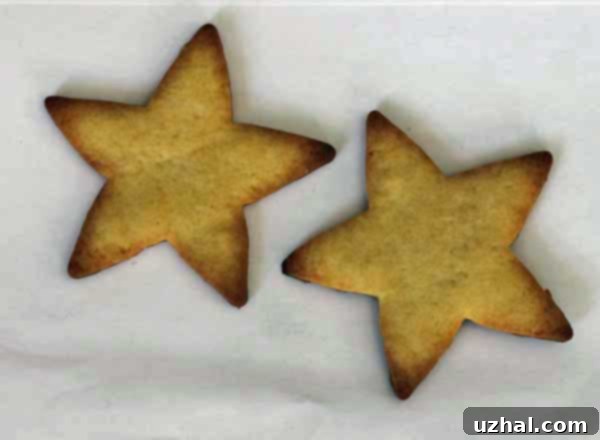Classic Cut-Out Sugar Cookies with Shortening: A Timeless Recipe for Perfect Frosted Treats
There’s a special joy in baking, and sometimes, the best recipes are the ones passed down through generations. This particular cut-out sugar cookie recipe holds such a cherished history, arriving in my kitchen courtesy of my wonderful baking buddy, Linda. For years, it has been her go-to, and now, I can proudly say it has become one of mine too! This culinary gem originates from an old publication, charmingly titled “Everyone Likes Cookies,” issued by the Rochester Gas and Electric Home Service Department in New York. We suspect this delightful booklet dates back to the early 1960s, a period when home baking was a cherished tradition and simple, reliable recipes were highly prized.
What makes these cookies truly remarkable? They strike a perfect balance that’s often hard to achieve. They are “not too sweet,” which is absolutely ideal, as it creates a blank canvas for generous amounts of frosting without becoming cloyingly rich. The texture is “very light,” offering a delicate crispness that makes each bite a pleasure. And while they are “very brown,” this isn’t a flaw; rather, it’s a testament to their delightful, slightly caramelized exterior that contributes to their distinctive flavor. Crucially, their robust structure makes them the “perfect vehicle for holding lots of frosting,” a quality every decorator dreams of in a cut-out cookie.
This recipe truly shines for any holiday or special occasion that calls for beautifully decorated cut-out sugar cookies. Whether it’s Valentine’s Day, Christmas, Halloween, or a birthday celebration, these cookies provide an excellent foundation. The heart-shaped cookies featured in the first photograph, adorned with vibrant red royal icing, were lovingly prepared for one of Fuzzy’s old school parties. Their crisp edges and flat surface made them ideal for intricate decorating. Further down, you can see a couple of star-shaped cut-outs. As you’ll observe, these cookies are exceptionally good at maintaining their shape during baking, resulting in stars with wonderfully sharp points and clean lines. This is a critical factor for anyone who enjoys making detailed cookie designs, as it prevents frustrating spreading and distortion.
Beyond their structural integrity, the subtle flavor profile of these sugar cookies makes them incredibly versatile. The moderate sweetness ensures that they pair harmoniously with a wide array of frosting flavors, from rich chocolate ganache to tangy lemon buttercream or classic vanilla royal icing. This balance allows the flavor of your chosen frosting to truly shine, making the decorated cookie a cohesive and delicious treat rather than an overpowering sugar bomb. The “very light” texture also means they aren’t overly dense, providing a pleasant contrast to thicker icings. It’s this thoughtful design, perhaps unintentional in its original creation, that makes this vintage recipe a standout even today.

The Magic of Shortening: Achieving Perfect Crispness in Your Sugar Cookies
An important update and clarification on this recipe: I continue to absolutely adore these cookies, and after countless batches, my opinion only strengthens. While they don’t possess the distinct buttery flavor that some might associate with sugar cookies, the choice of shortening is precisely what gives them their unique and highly desirable crisp, snappy texture. In recent years, I’ve opted for non-hydrogenated shortening, which offers a healthier alternative without compromising the structural integrity or delightful bite of the cookie.
Shortening, unlike butter, is 100% fat and contains no water. This fundamental difference is key to its role in baking. When butter bakes, its water content evaporates, which can contribute to steam and a softer cookie. Shortening, on the other hand, creates a more tender, crisp crumb and helps prevent the cookies from spreading excessively in the oven. This means your intricate cut-out shapes – whether they’re delicate snowflakes, detailed animals, or sharp-edged stars – will hold their form beautifully, yielding professional-looking results every time.
Because shortening has a very neutral flavor profile, it allows other flavors to take center stage. This is why I often enhance the recipe by adding a little more vanilla extract than originally called for, alongside a dash of almond extract. These additions introduce a delightful aroma and taste that perfectly complement the cookie’s texture and provide an excellent base for any frosting. Don’t be afraid to experiment with other extracts like lemon, peppermint, or even a touch of rum extract to customize the flavor for different occasions. The goal is to create a well-rounded cookie that balances its crisp texture with a pleasant, subtle sweetness and aromatic depth.
Baking at 400°F: The Secret to Golden Brown Perfection
One of the most intriguing aspects of this vintage recipe is its instruction to bake at 400 degrees Fahrenheit. In an era where many sugar cookie recipes call for 350-375°F, this higher temperature might seem unusual. However, it’s a critical element in achieving the specific characteristics of these cookies: that lovely “very brown” and wonderfully crispy finish. Baking at a slightly higher temperature accelerates the Maillard reaction, contributing to that desirable golden-brown color and a deeper, more complex flavor in the cookie itself.
While 400°F delivers exceptional results, it does require vigilance. These cookies can go from perfectly golden to over-baked quickly. My advice is to keep a close eye on them, especially during the last few minutes of baking. If your oven tends to run a little hot, or if you prefer a more leisurely baking pace, reducing the temperature to 375°F works very well, though you might need to extend the baking time slightly and adjust for a slightly less pronounced “brown” finish. The goal is always to achieve a cookie that is set, firm, and beautifully colored without being burnt. Ultimately, trust your senses – the smell of freshly baked cookies and a visual check are your best guides.
Why These Cookies Are a Decorator’s Dream
The quest for the perfect cut-out sugar cookie often boils down to two main criteria: how well they hold their shape and how well they serve as a canvas for frosting. This recipe excels at both. The shortening-based dough is less prone to spreading, which means your intricate cookie cutter designs – from delicate flowers to detailed animals – will emerge from the oven looking almost exactly as they went in. This precision is invaluable for holidays like Christmas, where reindeer antlers and gingerbread men limbs can easily become blurred if the dough spreads too much.
Furthermore, their flat, firm surface and moderate sweetness make them an ideal candidate for all kinds of decorating. Royal icing, with its smooth finish and ability to dry hard, creating beautiful, detailed designs, adheres perfectly to these cookies. Buttercream, whether American or Swiss meringue, also works wonderfully, offering a creamier, softer texture. The sturdy nature of the baked cookie ensures that it won’t crumble or break under the weight of piped decorations or when being handled, making them perfect for gifting, cookie swaps, or selling at bake sales. This old-fashioned recipe truly stands the test of time, proving that sometimes, the simplest ingredients yield the most satisfying results for both the baker and the decorator.
- Candy Corn Pizza Slices
- Final Word on Self-Frosting Pineapple Coconut Cake
- Buttercream Frosted Half Moon Cookies
- Strawberry Bread Recipe
- Cut-Out Cookies with No-Fail Icing
Recipe

An Old Cut-Out Sugar Cookie Recipe
Cookie Madness
Pin Recipe
Ingredients
- 1 cup shortening
- 4 cups all purpose flour (460 grams)
- ½ teaspoon salt
- 2 large eggs
- 1 cup sugar (200 grams)
- ¼ cup whole milk or reduced fat milk with a teaspoon of cream mixed in
- 1 teaspoon vanilla plus a little almond extract if desired
- 1 teaspoon baking soda
Instructions
-
Preheat your oven to 400 degrees F (200 degrees C). Prepare two baking sheets by lining them with parchment paper; this prevents sticking and aids in easy cleanup.
-
In a large mixing bowl, “cut” the shortening into the flour. This means breaking the shortening into small pieces and mixing it thoroughly with the flour until the mixture resembles coarse crumbs. I prefer to do this by hand, but a food processor can certainly make this step quicker. Once combined, add the salt and stir well to distribute evenly.
-
In a separate, second bowl, combine the eggs and sugar. Beat these ingredients together until they are well-combined and slightly pale. A hand-held mixer works perfectly for this step, ensuring a smooth and airy mixture.
-
In a small cup or bowl, whisk together the milk, vanilla extract (and almond extract, if using), and baking soda. The baking soda will activate slightly with the milk.
-
Gradually add both the beaten egg-sugar mixture and the milk-vanilla mixture to the flour-shortening mixture. Stir until all ingredients are just blended and a cohesive dough forms. Avoid overmixing, as this can lead to tough cookies. At this point, I often chill my dough for about 30 minutes to an hour. While the original recipe doesn’t explicitly require chilling, it makes the dough easier to handle and can help prevent spreading.
-
Lightly flour a clean work surface. Take a portion of the dough (I usually work with half or a quarter at a time, never the entire batch) and roll it out to about ¼ inch thick. Use your favorite cookie cutters to cut out shapes. Carefully transfer the cut-out cookies to your prepared baking sheets. Bake for 8-12 minutes, or until the edges are golden brown and the cookies appear set. Remember, these cookies tend to get quite brown, which contributes to their characteristic crispness. Baking time will vary based on your oven and cookie thickness, so watch them closely.
-
Once baked, remove the cookies from the oven and let them cool on the baking sheet for a few minutes before transferring them to a wire rack to cool completely. This helps them firm up. Once fully cooled, they are ready to be iced with your preferred royal frosting or buttercream.
Notes
My baking friend Linda has experimented extensively with this recipe, trying various ratios of shortening to butter. Her conclusion, and one I wholeheartedly agree with, is that the all-shortening version consistently delivers the best texture – a perfectly crisp and snappy bite that stands up beautifully to frosting. If you enjoy the flavor of Butter Flavored Crisco, you could certainly try using that for a subtle buttery note. However, I’ve found that the added vanilla and almond extracts provide ample flavor, and I genuinely don’t miss the butter flavor in the cookie itself. Plus, the beauty of these cookies is that you can incorporate a lot of butter into your chosen frosting! These versatile cookies truly shine with a generous layer of frosting, which completes their flavor and texture profile.
